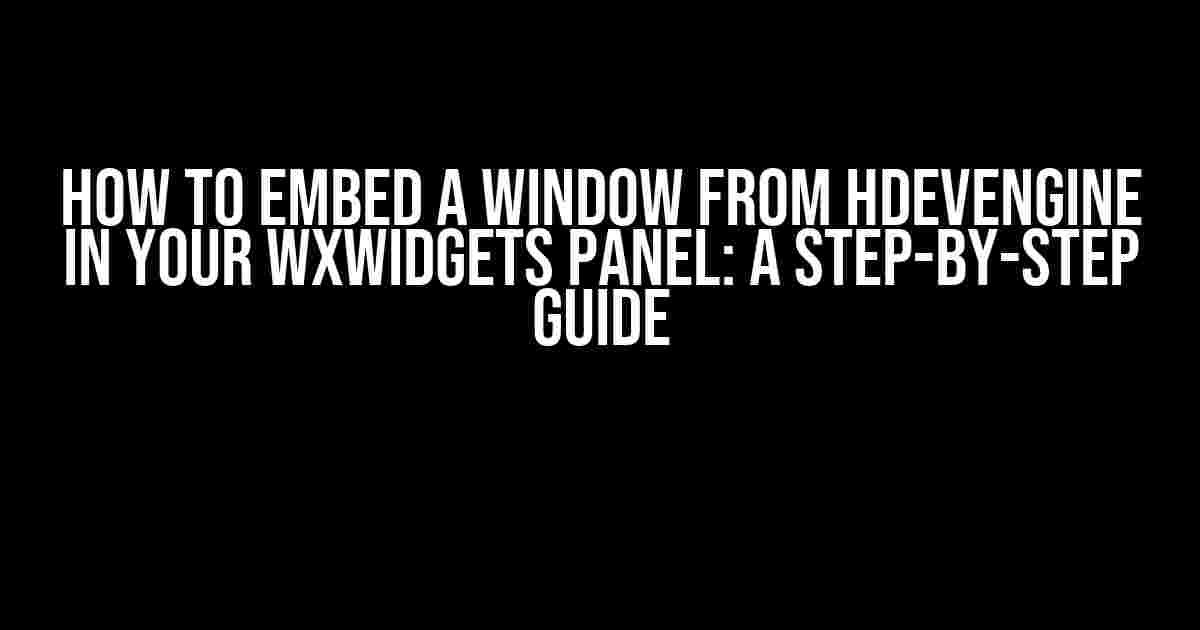Are you trying to integrate HDevEngine into your wxWidgets application and having trouble figuring out how to embed a window from HDevEngine in your wxWidgets panel? Look no further! This comprehensive guide will walk you through the process of embedding a HDevEngine window in your wxWidgets panel, providing clear and direct instructions and explanations along the way.
What is HDevEngine and Why Use It?
HDevEngine is a powerful game development engine that allows developers to create high-quality, 2D and 3D games with ease. With its robust feature set and extensive library of APIs, HDevEngine is an ideal choice for game developers looking to create complex, visually stunning games. But what if you want to integrate HDevEngine into your existing wxWidgets application? That’s where this guide comes in.
Why Use wxWidgets?
wxWidgets is a cross-platform GUI framework that allows developers to create native-looking applications for Windows, macOS, and Linux. With its simplicity, ease of use, and extensive library of widgets, wxWidgets is a popular choice for building GUI applications. By integrating HDevEngine with wxWidgets, you can create a seamless and immersive gaming experience for your users.
Prerequisites
Before we dive into the guide, make sure you have the following:
- HDevEngine SDK installed on your system
- wxWidgets framework installed on your system
- A basic understanding of C++ programming
- A wxWidgets project set up in your preferred IDE
Step 1: Create a wxWidgets Panel
First, create a new wxWidgets panel in your project. You can do this by creating a new wxPanel object and adding it to your main wxFrame.
#include <wx/wx.h>
class MyFrame : public wxFrame
{
public:
MyFrame() : wxFrame(nullptr, wxID_ANY, "HDevEngine Integration")
{
wxPanel* panel = new wxPanel(this, wxID_ANY);
// Add panel to sizer and set up layout
}
};
Step 2: Initialize HDevEngine
Next, initialize HDevEngine in your wxWidgets application. You’ll need to include the HDevEngine headers and link against the HDevEngine library.
#include <HDevEngine/HDevEngine.h>
class MyFrame : public wxFrame
{
public:
MyFrame() : wxFrame(nullptr, wxID_ANY, "HDevEngine Integration")
{
// Initialize HDevEngine
HDevEngine::Init();
// ... rest of code ...
}
};
Step 3: Create a HDevEngine Window
Create a new HDevEngine window and set up its properties. You can customize the window’s size, position, and other attributes to fit your needs.
#include <HDevEngine/HDevEngine.h>
class MyFrame : public wxFrame
{
public:
MyFrame() : wxFrame(nullptr, wxID_ANY, "HDevEngine Integration")
{
// Create a new HDevEngine window
HDevEngine::Window* window = HDevEngine::CreateWindow(0, 0, 800, 600);
window->SetWindowFlags(HDevEngine::WindowFlags::WINDOW_RESIZABLE);
window->SetWindowTitle("HDevEngine Window");
// ... rest of code ...
}
};
Step 4: Embed the HDevEngine Window in Your wxWidgets Panel
This is the crucial step where you’ll embed the HDevEngine window in your wxWidgets panel. You’ll need to create a wxWindow object and set its parent to your wxPanel. Then, you’ll need to set the HDevEngine window’s parent to the wxWindow object.
#include <wx/wx.h>
#include <HDevEngine/HDevEngine.h>
class MyFrame : public wxFrame
{
public:
MyFrame() : wxFrame(nullptr, wxID_ANY, "HDevEngine Integration")
{
wxPanel* panel = new wxPanel(this, wxID_ANY);
wxWindow* wxWindow = new wxWindow(panel, wxID_ANY, wxDefaultPosition, wxDefaultSize);
HDevEngine::Window* window = HDevEngine::CreateWindow(0, 0, 800, 600);
window->SetParent(wxWindow);
// ... rest of code ...
}
};
Step 5: Handle Events and Input
Finally, you’ll need to handle events and input for the HDevEngine window. You can use wxWidgets’ event handling mechanism to capture events from the HDevEngine window and respond accordingly.
#include <wx/wx.h>
#include <HDevEngine/HDevEngine.h>
class MyFrame : public wxFrame
{
public:
MyFrame() : wxFrame(nullptr, wxID_ANY, "HDevEngine Integration")
{
// ... rest of code ...
Connect(wxID_ANY, wxEVT_KEY_DOWN, (wxObjectEventFunction)&MyFrame::OnKeyDown);
}
void OnKeyDown(wxKeyEvent& event)
{
// Handle key down event
HDevEngine::Window* window = GetHDevEngineWindow();
window->OnKeyDown(event.GetKeyCode());
}
};
Troubleshooting Common Issues
If you encounter issues while embedding the HDevEngine window in your wxWidgets panel, here are some common solutions:
| Issue | Solution |
|---|---|
| HDevEngine window not displaying | Check that you’ve set the HDevEngine window’s parent correctly to the wxWindow object. |
| HDevEngine window not responding to input | Make sure you’ve connected the necessary events and handled input correctly. |
| HDevEngine window not resizing correctly | Check that you’ve set the HDevEngine window’s flags correctly to allow resizing. |
Conclusion
That’s it! With these steps, you should now have a fully functional HDevEngine window embedded in your wxWidgets panel. Remember to troubleshoot any issues that arise and consult the official documentation for both HDevEngine and wxWidgets if needed.
By following this guide, you can unlock the full potential of HDevEngine and wxWidgets, creating immersive and engaging gaming experiences for your users. Happy coding!
Frequently Asked Question
Getting started with embedding a Window from HDevEngine in your wxWidgets panel can be a bit tricky, but don’t worry, we’ve got you covered!
Q1: What are the prerequisites for embedding a Window from HDevEngine in my wxWidgets panel?
To get started, you’ll need to have HDevEngine and wxWidgets installed on your system. Make sure you have the necessary libraries and headers included in your project. You’ll also need to create a wxWidgets panel and a Window from HDevEngine that you want to embed.
Q2: How do I create a Window from HDevEngine that can be embedded in my wxWidgets panel?
To create a Window from HDevEngine, you’ll need to create an instance of the HDevEngine Window class and set its parent window to NULL. This will allow the Window to be embedded in your wxWidgets panel. You can then customize the Window as needed using HDevEngine’s API.
Q3: How do I embed the HDevEngine Window in my wxWidgets panel?
To embed the HDevEngine Window in your wxWidgets panel, you’ll need to use the wxWidgets API to create a wxWindow object and set its parent window to your wxWidgets panel. Then, you can use the HDevEngine Window’s HWND or handle to embed it in the wxWindow object.
Q4: How do I handle events and messaging between the HDevEngine Window and my wxWidgets panel?
To handle events and messaging between the HDevEngine Window and your wxWidgets panel, you’ll need to use the HDevEngine API to set up event handlers and the wxWidgets API to handle wxWidgets events. You can use the HDevEngine Window’s event handling mechanism to communicate with your wxWidgets panel and vice versa.
Q5: Are there any known issues or limitations when embedding a HDevEngine Window in a wxWidgets panel?
Yes, there are some known issues and limitations when embedding a HDevEngine Window in a wxWidgets panel. For example, you may need to handle issues related to window focus, resizing, and Z-ordering. Additionally, some HDevEngine features may not be compatible with wxWidgets, so be sure to check the documentation for both libraries to ensure compatibility.



